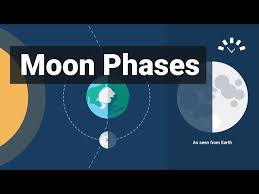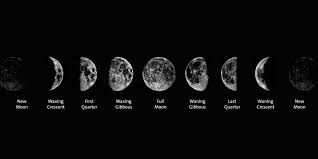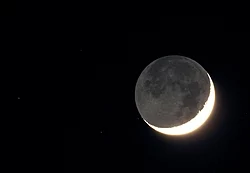WHAT ARE LUNAR PHASES?
New moon, waxing crescent, first quarter, waxing gibbous, full moon, waning gibbous, third quarter, and declining crescent are the eight phases of the moon.
The apparent form of the Moon’s directly illuminated area as seen from Earth is known as a lunar phase or moon phase. The same hemisphere is constantly facing the Earth due to the Moon’s tidal lock with the planet. The new moon, first quarter, full moon, and last quarter are commonly referred to as the four main phases. The four minor phases are waxing crescent, waxing gibbous, declining crescent, and waning gibbous. The period of time between consecutive recurrences of the same phase is known as a lunar month; because of the Moon’s orbital eccentricity, this period is not exactly constant, although it typically lasts 29.5 days.

WHAT ARE THE 8 LUNAR PHASES?
New, waxing crescent, first quarter, waxing gibbous, full, waning gibbous, last quarter, and waning crescent are the eight phases of the moon.
IS THE LUNAR PHASES CYCLE 27 DAYS?
Although the Moon’s orbit around the Earth only takes 27 days, its phases repeat every 29.5 days.

WHAT DOES THIS 🌗 EMOJI MEAN?
shows the moon as a cratered disc with half of its left side glowing in gold or silver and the other half black. may be used to symbolise astronomy, darkness, space, and the moon in general. It can also be used to express strange or captivating emotions. Also see Moon Face 🌜 Last Quarter.
HOW TO CALCULATE MOON PHASES?
By calculating the number of days since a known new moon (such January 1, 1900, or August 11, 1999), then dividing that number by 29.53059 days (the average duration of a synodic month), one may get the Moon’s estimated age and, consequently, its approximate phase for any given date.

WHAT IS THE LUNAR MONTH CALLED?
An interval of 28 to 30 days between new moons is referred to as a lunar month. The term “tithi” refers to each day of the lunar month.
HOW LONG IS A LUNAR DAY?
However, a lunar day is 24 hours and 50 minutes longer than a solar day. Because the moon spins around the Earth in the same direction that the Earth rotates on its axis, a lunar day is fifty minutes longer than a solar day. The Earth thus needs an additional half hour to “catch up” to the moon.

As the relative orbital locations of the Earth and the Moon around the Sun vary over the course of a lunar month, the Moon’s appearance (or phase) progressively changes as well. Depending on where the Moon is in its orbit, the visible side of the Moon receives different amounts of sunlight; during a new moon, this amount is 0%, while at a full moon, it is almost 100%.
FOUR PRINCIPALS OF LUNAR PHASES?
When the Moon’s ecliptic longitude is at an angle to the Sun (as viewed from the centre of the Earth) of 0°, 90°, 180°, and 270°, respectively, there are four principal (primary, or major) lunar phases: the new moon, first quarter, full moon, and last quarter (sometimes called the third or final quarter). Tabulated timings are always geocentric (estimated for the centre of the Earth) since each of these phases manifests at slightly different times at different locations on Earth.
There are intermediate phases in between the primary phases, when the lighted Moon appears to be either crescent or gibbous. The intermediate phases typically last 7.38 days, or one-fourth of a synodic month.
LUNAR LIBRATION:
The Moon’s eccentric orbit causes it to seem somewhat different in size and from slightly different angles when viewed from Earth. In time-lapse photography, the effect is slightly visible, although it is not noticeable to the unaided eye from night to night.
A portion of the Moon’s back side can occasionally be seen by a terrestrial observer due to lunar libration. As a result, approximately 59% of the Moon’s surface has been captured on camera.





